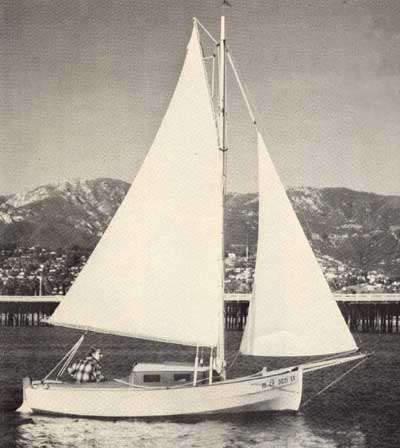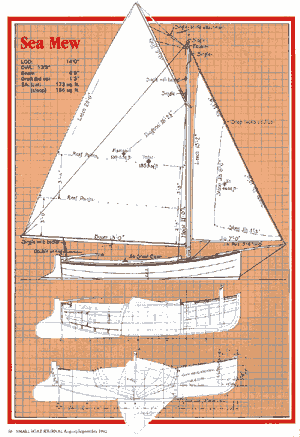| She had only 14 feet overall, with a 6-foot
8-inch beam and a 3-foot centerboard. Frames were of straight
sawn oak, bottom planking of Va-inch cedar and side planking of
1/2 inch cedar. This was the old Sea Mew; a traditional catboat
designed by Frederick William Coeller, Jr. just before the first
world war.
He intended her to be a strong, inexpensive, and seaworthy craft
suitable for home construction and for use as a trainer in junior
sailing programs. Later Goeller added plans for a sloop rig, both
gaff and Marconi, reducing the main boom from 15 feet to 13 feet,
and adding a 2-foot 9-inch bowsprit for the jib.
This tiny boat, with hard chines and stubby shape, proved to
be a good trainer and a good sea boat as well. The design really
began to catch on after the war when plans were carried by Rudder.
Like most of the plans appearing in the old magazine, the Sea
Mew was inexpensive to build, relatively uncomplicated, and just
right for backyard builders. Full cost of the boats, even from
a professional boatyard, was under $300 in those early years.
Requests for construction plans swamped the publisher.

Above: a sloop-rigged Sea Mew with removable
cuddy beats out of the harbor.
Shortly after publication of the plans in Rudder, the Long Beach
(Calif.) Sailing Club, under the sponsorship of the local recreation
department, had a small fleet of Sea Mews built for its instruction
program. Other fleets sprang up in San Diego, in nearby Newport,
and in Santa Barbara.
Many of the early Sea Mews were built by the Fellows and Stewart
Boatyard on Terminal Island. Those intended for Santa Barbara,
old-timers recall, were towed north in strings of four or five
by local fishing boats which had off loaded their cargo in San
Pedro and were headed back to Santa Barbara. It is believed as
many as twenty Sea Mews finally found their way there, beginning
in 1923 and continuing through the decade. Some went to the Santa
Barbara Yacht Club, for its junior sailing program, when others
were intended for individual owners.
All of these original Sea Mews were gaff cats, considered the
simplest rig for beginners. And because all boats were built to
the same specifications, class racing was common up and down the
coast and between competing harbor fleets.

A clever, Davis innovation is
a convertible cuddy-cabin top. Held in place by toggles, it can
be quickly removed so that the boat can be used as an open daysailer
or, with the top back on, cruised by two on overnight trips.

Racing dropped off when optional rigs became more common after
1930. With the new sloop rigs came experimentation with different
keels and ballast. Internal ballast, usually cement blocks cast
to fit between frames, was adopted early. Some fitted a "boiler
plate" fin keel in place of the centerboard; others went
to a shoe keel. So while use of the Sea Mew as a class boat for
racing declined, its popularity with individual owners continued.
Though most of the early Sea Mews came to Santa Barbara from
Los Angeles boatyards, some of the individual orders were filled
locally as well. Several of the designs were turned out in the
early 1930s at the old Lindwall boatyard. Harry Davis built his
first wooden Sea Mew in Long Beach in 1947 and continued to build
them after he moved to Santa Barbara. Around 1960, John Hooper
built another four, this time using the edge nailed and glued,
strip-plank method in place of traditional lapstrake.
A few of the old wooden Sea Mews still survive—some well
cared for and sailed regularly; others are on blocks in scattered
backyards, waiting for someone who cares to restore them. Some
ot the type are reported to have remained active as rental boats
into the 1950s, and perhaps into the 60s as well, at the historic
Victorian Hotel
Del Coronado in San Diego and in Santa Barbara.
|
Left: Harry
Davis poses before one of his fiberglass Sea Mews, the first
of which he built in 1965. |
Harry Davis deserves most of the credit for continued attention
to the design in California. Davis has been a respected and well-loved
boatbuilder in Santa Barbara for decades. He learned to sail in
the original Sea Mew fleet under Frank Davenport in Alamitos Bay,
Long Beach, in the early twenties. The little vessel — its
lines, its sea kindly qualities, and its sailing ability —
all left a lasting impression on Davis.
When he turned to boatbuilding as a profession, Davis determined
to keep the Sea Mew alive. He built his first one in the late
forties. In 1965, the Lark, his last wooden Sea Mew hull, became
the plug for a fiberglass mold. Since then, Davis has regularly
turned out several boats each year for customers up and down the
West Coast.
All of his fiberglass models have been gaff sloops, with 3 foot
bowsprit, 12-foot main boom, and a 22-foot solid spruce mast with
3-1/2 inch diameter, tapering to 2-1/4 inches. The boats carry
a shallow draft, with a 2-foot hollow box keel containing some
300 pounds of lead. The fiberglass version is somewhat lighter
than the original wooden in the keel to match the stability of
the old design.
A clever, Davis innovation is a convertible cuddy-cabin top.
Held in place by toggles, it can be quickly removed so that the
boat can be used as an open daysailer or, with the top back on,
cruised by two on overnight trips.
| Right: an early modern
example awaits the patient hands of a restorer. |
|
The boat is easily trailered and is especially popular with
small families because it is stiff, dry, and forgiving. As Bruce
McCurdy, a current owner puts it: "With the Sea Mew, I feel
in charge. I don't need a crew everytime I want to sail, and I
can get underway quickly." McCurdy says his Sea Mew is lively
and can often hold her own with bigger boats, especially in light
air. He and his young son often take their Sparrow out for day-long
fishing trips and overnight cruises along the Santa Barbara Channel.
A bigger boat, he notes, would be more difficult to maintain properly.
Another Santa Barbara Sea Mew booster is Ed Lewis, now retired,
who acquired one of the little craft as a youth, added a boiler
plate fin keel and cuddy, and cruised her extensively along the
coast, as far as San Francisco. The boat was incredibly seaworthy,
he recalls; handily weathering blows in the Santa Barbara Channel
when the only craft out were his little La Tortuga and the Coast
Guard.
When I took a Sea Mew out, I discovered she was all I had been
led to expect. She was quick to get underway — hoist the
main and jib, push off from the dock, and pick up a patch of wind
to move easily down the harbor channel. I set off in light air,
but she ghosted along readily. I never felt the urge to get out
and push or start an outboard engine. In fact, the good old "ash
breeze" would do very nicely if you were caught out with
no wind.

(click to enlarge)
When the breeze freshened outside the harbor, the pace picked
up, but she hardly heeled at all as she bounded joyfully from
wave top to wave top. The Sea Mew is not a racer, nor does she
point particularly high, but this is a splendid boat for leisure
time on the water, alone or with the family. We had three adults
in the cockpit and could have added a fourth.
The Sea Mew is now more than 60 years old. Yet it is in a remarkable
state of health in southern California. Though Harry Davis is
semi-retired, his old shop still has the Sea Mew molds. A new
hull was recently finished for a customer up north. For those
interested in doing some of their own work, a few old plans can
still be found if you ask around, and there are a few older hulls
that could be restored to prime condition.
While l was photographing an owner-built Sea Mew recently, an
older man came along and stood beside me. He looked at the boat
for just a moment, then exclaimed with surprise: "Why, I
learned to sail on a boat like that back on Cape Cod Bay when
I was a boy." It must have been 50 years ago, but his recollection
of that experience was still fresh and vivid. Afine tribute to
a lovely old sailing craft.
Bill Anderson, a fiberglass specialist, has taken over Harry
Davis old business, including the Sea Mew molds. He can be reached
at 325 E. Cabrilio Blvd., Santa Barbara, CA 93101: tel. (805)
965-6696.

|

